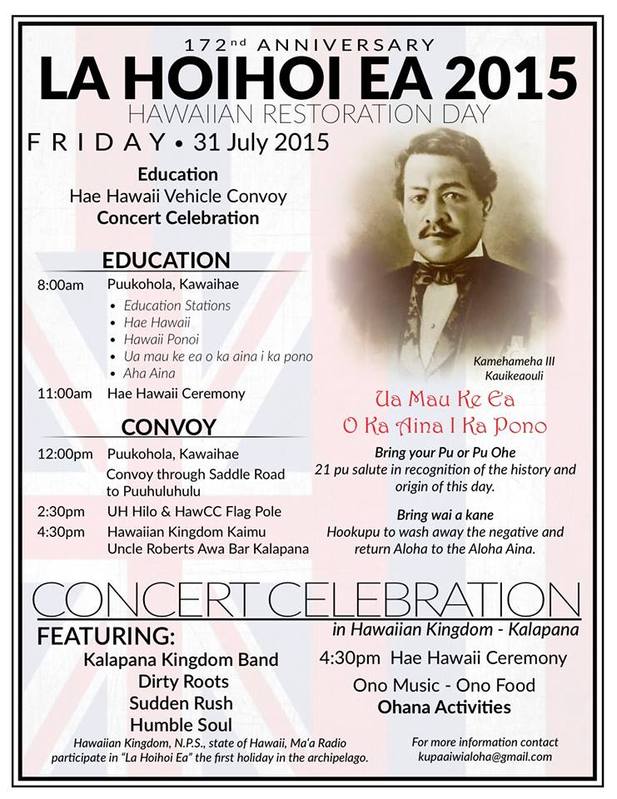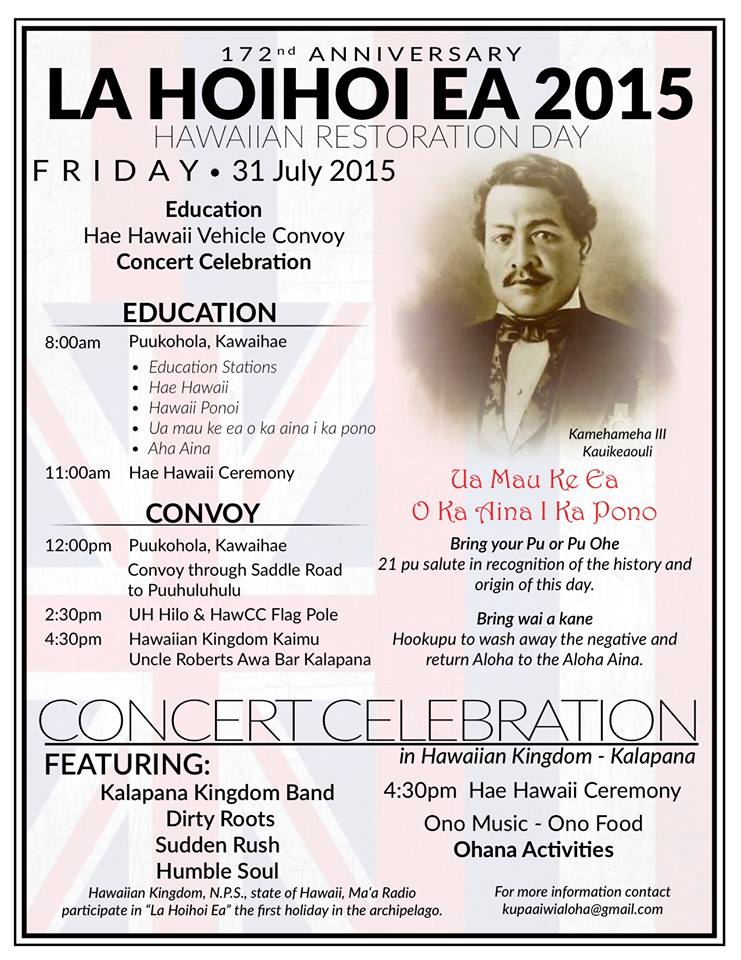
|
||||||
|
Back in ’94 I think, I walked with a group of Ohana Council members down Waikiki Beach and handed out copies of the Apology along with a flyer urging tourists not to come to Hawaii due to the ongoing suppression of Hawaiian Kingdom rights. A couple dozen of us for an hour or two were enough to send the state’s tourism industry into a near panic and result in a meeting with the governor and members of his cabinet soon thereafter. Now, Bumpy is ready to do it again. “I will tell the tourists not to come to Hawaii until you guys sit down with us.” Also, note towards the end his reflections on the role of Japanese in Hawaii of in a sense usurping the benefits and programs that were intended for Hawaiians. This is a sensitive subject but it is very real and important to understand, and something Bumpy feels strongly about.
Ryan Ozawa reviews Anthony Bourdain’s “Parts Unknown” episode on Hawaii that airs on Sunday, June 14 at 3 p.m. Hawaii time (9 p.m. ET/PT).
Ke Aupuni Update
June 9, 2015
Keeping in touch and updated on activities regarding the restoration of Ke Aupuni o Hawaii, the Hawaiian Kingdom. Ua Mau Ke Ea O Ka Aina I Ka Pono.
———
Aloha kakou.
The past 3 weeks back in the islands has been amazing. The advances made in Geneva and New York are more than matched here at home by the growing enthusiasm for restoring our nation. The vision for a Free Hawaii based on the principles of Kapu Aloha is coming more clearly into focus.
Ku Kia’i Mauna
Mahalo for those protecting Mauna a Wakea. Your Ku’e and living examples of Aloha are breaking through many barriers, especially those among our own people. Your Ku’e on all fronts is exposing—big time—the games being played by the different “players” (the state, the university, the foreign countries, the corporations, the scientific institutions). Even when they talk aloha ‘aina, their true motive? Money. OHA it turns out just wanted a cut of the action.
Aloha Movie
If you get a chance, go see the movie, “Aloha” (starring Bradley Cooper and Emma Stone). It has some good scenes that should pique people’s interest in our movement. Bumpy does a great job. Don’t worry about them calling Bumpy “king.” What the movie does in a very matter-of-fact way, is confront people with a different reality about Hawaii…that Hawaii is still a sovereign nation and that we are a people working to restore our nation. I’m not concerned about the title. The term “Aloha” has endured much greater abuse than this and has still emerged pure and kapu in the minds and hearts of people all over the world.
Briefings on recent UN breakthrough
I will be giving two talks that are open to the public to attend: 1) on Kauai Thursday, June 11 and 2) on Oahu, June 12. The talks will be on recent gains made at the international level toward asserting the sovereignty of our nation. (see attached flyers)
Next week, I will be headed for New York and Geneva again to continue lobbying countries and building support for Hawaiian independence.
A hui hou,
Malama pono,
Leon
This BuzzFeed News story by Michelle Broder Van Dyke on the movie ‘Aloha’ is an absolute must read to understand Bumpy’s perspective on the movie ‘Aloha’ and Cameron Crowe’s relation with Bumpy and the village of Puuhonua o Waimanalo. While controversy over the film’s title and racial aspects of casting have overshadowed other aspects of the movie, Bumpy notes the “megaphone platform Crowe had afforded the Hawaiian rights movement.”
In the midst of seeking some entertainment and thinking whatever else they think about the movie, millions of people will hear these truths about Hawai‘i, thanks to Bumpy and Cameron.
HILO, Hawaii – The Hawaii County Council Committee on Governmental Relations and Economic Development took up a rare discussion on Hawaiian sovereignty in Hilo on Tuesday. Puna Councilman Danny Paleka introduced a resolution requesting the Hawaii state legislature designate July 31st as Lā Ho‘iho‘i Ea, recognizing the day independence was restored to the Kingdom of Hawai‘i in 1843 following a taking by the British Royal Navy. From the “whereas” section of Resolution 185-15:
The measure drew lots of testimony from subjects of the Hawaiian Kingdom. The discussion also hit home for some councilmembers who have deep roots on the island. The entire council voted to pass the resolution, which will go to the full council for a vote in the next few weeks. Public Testimony: Council Discussion: [Note: I know Ed Rampell from back in the Ohana Council days, and with his knowledge of Hawaii film history (having written multiple books on the subject, as noted in the mini-bio at the bottom) and being familiar with Hawaiian independence movement for almost three decades, he is uniquely suited to offer a meaningful review of theme ‘Aloha’ related specifically to the role Bumpy and the movement plays in the movie. Here’s his review…] Controversial Aloha co-stars Hawaiian independence leaderBy Ed Rampell Note: This piece contains plot spoilers. A lynch mob is attacking writer/director Cameron Crowe’s new movie Aloha, which opened May 29. The 2014 leaking of confidential messages after Sony Pictures Entertainment executives’ email accounts were hacked (allegedly by North Koreans angered by The Interview) revealed critical comments of Aloha by anxious execs. The Media Action Network for Asian Americans observed that Aloha‘s cast is too white for a movie shot in Hawaii, where Caucasians are a minority. The 50th state’s film commissioner complained Aloha‘s title misappropriated the spiritual meaning of that word, which translates as “love,” “hello” and “farewell.” Even panelists on Fox News’ “The Five” – a program specializing in aggressive imbecility- debated Aloha. Introducing a May 26 advance screening at a Los Angeles theater, Crowe seemed to dismiss his detractors, pithily saying, “Lots has been heard from people who have never seen the movie.” In any case, the most controversial thing about Aloha may be Crowe’s casting of Hawaiian independence leader Dennis “Bumpy” Kanahele. Despite the typical Hollywood disclaimer during the closing credits about the motion picture’s characters being fictitious, Kanahele is very much a real person and the non-actor plays an onscreen version of himself bearing the same name. Continue reading Controversial Aloha co-stars Hawaiian independence leader Chad Blair has a ranging review of ‘Aloha’ movie in Civil Beat, which includes this:
(By the way, those are upside down Hawaiian Kingdom flags.) There are tons of reviews out there for the movie ‘Aloha.’ Whatever else critics may object to, they have mostly positive takes on Bumpy’s role in the film, and how his character (basically playing himself) is treated respectfully, and conveys a genuine voice about Hawaiian issues, history and culture. But I want to draw your attention to this blog post by Shay Chan Hodges, who brings a somewhat inside perspective on the filming of the movie and the issues it takes on, including the failure of Bank of America to live up to its still outstanding commitments to the Hawaiian people. Here’s an excerpt, but please read the whole thing.
|
||||||
|
Copyright © 2025 Hawaiian Kingdom Independence Blog - All Rights Reserved Powered by WordPress & Atahualpa |
||||||



